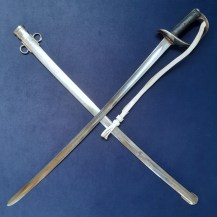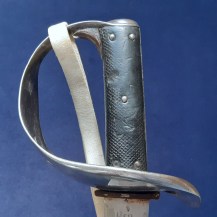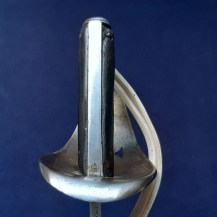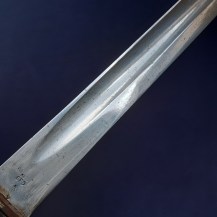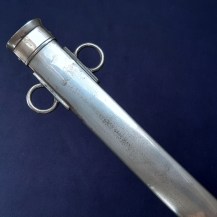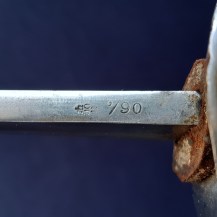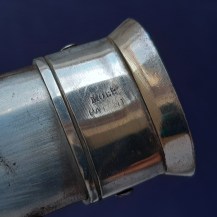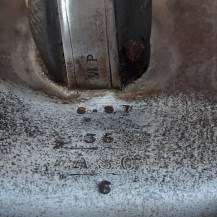British 1890 Pattern Cavalry Trooper’s Sword, Duke of Lancaster’s Own Yeomanry
Curved, single fullered blade, ambidextrous basket hilt with pierced Maltese Cross symbol and turned-over edges, black pressed leather grips secured by five steel rivets, brown leather washer. Steel scabbard with fixed opposed hanging rings. Overall length 38 7/8 inches (98.7cm) blade length 33 3/8 inches (84.7cm). Traces of orange-brown paint to the lip of the guard on one side.
The spine of the blade is stamped with ‘/90’, indicating that it is an 1890 Pattern, and a crown inspection mark for Enfield. The flat of the blade is stamped at the forte on one side with a broad arrow and ‘EFD’, indicating War Department property made at Enfield, another Enfield inspection mark and an ‘X’ indicating that the blade passed a manufacturer’s bending test. On the other side it is stamped with an issue mark ‘97 for 1897, another for 1899, and two further Enfield crown inspection marks. The outside of the guard is stamped near the spine of the blade with another ‘EFD’ below a broad arrow. The inside of the guard is stamped with ‘8 97’ indicating issue in August 1897, matching that on the blade, and the unit mark ’13 / A.S.C. / 6’, indicating the Army Service Corps. The exposed tang is stamped near the guard with ‘M’ and ‘P’.
The scabbard is stamped at the face side of the throat with ‘8 1893’, above ‘Y / DLO / 212’, indicating sword number 212 issued to the Duke of Lancaster’s Own Yeomanry. The opposite face side is stamped with ‘MOLE PATENT’ indicating the manufacturer Mole of Birmingham. The trailing side of the throat piece is stamped with another /90, which probably indicates the pattern rather than manufacture date (which would be rendered ‘90). The flat spine of the scabbard body is similarly stamped with a broad arrow and ‘WD’, indicating War Department property, another /90 and a crown inspection mark with ‘B’ for Birmingham.
The dissimilar maker’s and unit markings on sword and scabbard suggest that they are a non-original pairing – whether they were brought together during their service life or later is impossible to tell, though they are in similar condition.
The Duke of Lancaster’s Own Yeomanry was formed in 1828 out of several troops of yeomanry based in the county of Lancashire. Initially named the Lancashire Corps of Yeomanry Cavalry, it was honoured by King William IV with the title ‘Duke of Lancaster’s’ in 1834 – the Duke of Lancaster being one of the British monarch’s several titles. In 1893 the DLOY had four squadrons, with its headquarters at Worsley. Together with the Lancashire Hussars it contributed two companies of volunteers to the Boer War, which operated as mounted infantry and earned the regiment’s first battle honour ‘South Africa 1900-02’.
It became part of the Territorial Force in 1908, headquartered in Manchester. Being one of the more senior yeomanry regiments in the TF it was chosen to remain a mounted cavalry unit after WW1. It mobilised as cavalry for WW2 but was abruptly transferred to the Royal Artillery in 1940. After WW2 it became an armoured reconnaissance unit. Its lineage is maintained by B Squadron of the Queen’s Own Yeomanry.
The Army Service Corps (ASC) was responsible for much of the transport and logistics of the British Army, supplying food, water, fuel, clothing and other domestic goods, as well as some technical equipment. Supplying armaments was the responsibility of the Royal Army Ordnance Corps. It was formed in 1888 out of the Commissariat and Transport Department, plus the War Department Fleet and some transport elements from the Royal Engineers.



